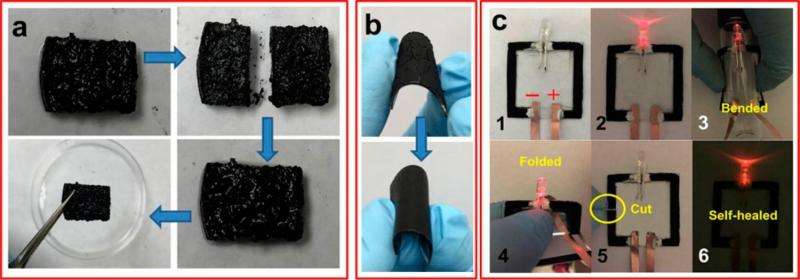Previously reported conductive self-healing materials usually need large amounts of inorganic conducting fillers and their self-healing behaviors are only activated under specific external stimuli, such as heat, light, pH, etc. Some supramolecular gels with self-healing properties have been developed in the past. However, they are seldomly adopted in practical applications due to weak mechanical strength and lack of high conductivity. In the meantime, nanostructured conductive hydrogels have been recently developed and demonstrated to be an ideal candidate to construct conducting network in hybrid gel materials, as well as acting as robust matrix to support other components. A new hybrid gel, developed by researchers at The University of Texas at Austin together with collaborators at Texas State University, is composed of conductive polymer and a metal-ligand supramolecule; the novel gel exhibits attractive properties associated with both conventional polymers, such as ease of synthesis and processing, and great self-healing performance at room temperature without any stimuli. The most important result of this work is the development of a supergel material which shows exciting features of high conductivity, appealing mechanical and electrical self-healing property without any external stimuli and enhanced mechanical strength and flexibility. "Owing to these exciting features, our designed hybrid gel could greatly extend the application of self-healing materials to flexible and printable electronics, artificial skins, durable medical devices, even in energy devices, etc.," Guihua Yu, an Assistant Professor of Materials Science at the University of Texas at Austin, tells Nanowerk. To demonstrate the potential for practical applications, Yu and his team fabricated thin films of the hybrid gel on flexible substrates to test their self-healing electrical properties. They showed that the high conductivity of the hybrid gel can be maintained after extensive bending and stretching tests due to their good self-healing property. Furthermore, they demonstrated with a simple electrical circuit made of the hybrid gel that, after being cut, it only takes about one minute for the circuit to self-heal and recover its original conductivity The researchers reported their findings in the August 13, online edition of Nano Letters ("A Conductive Self-Healing Hybrid Gel Enabled by Metal-Ligand Supramolecule and Nanostructured Conductive Polymer").[F1]
Figure 1. The hybrid gel could be self-healed through intermolecular interaction and dynamic coordination effects of supramolecular gel.
"In our work, we found that this supramolecular gel showed very appealing self-healing property without any stimuli because it could dynamically assemble or disassemble, associate or dissociate at room temperature due to the moderate bond energy of metal-ligand bonds and non-covalent interactions among supramolecules," Yu explains. "The conductive polymer gel serving as ‘host’, exhibited a hierarchically porous structure providing 3D interconnected paths for electron transport and an ideal interface." This work opens a field in which supramolecular gels could be used for numerous practical applications. Supramolecular gels with decent self-healing property could be hybridized with conventional polymers gels and the resulting hybrid gel materials could be used for various applications that require high conductivity, room-temperature self-healing property and decent mechanical properties. This material could potentially be applied in many technologic areas where conductive and self-healing materials are required. For examples, the hybrid gel could be used to construct conducting circuits in flexible electronics which would be self-repaired under physical damage.[F2] The gel can also be adopted in implantable biosensors to act as flexible electrode, ensuring the durability of these devices. In addition, the gel material could be used for the fabrication of artificial skins[F3]. Last but not the least, it can be used in many energy devices too. For example, as functional binder materials for advanced battery electrodes in high-density Li-ion batteries or other energy storage systems. "Fundamentally, in terms of synthetic strategies, our work synergizes the sol-gel transition property of supramolecular gel and hierarchically porous nanostructure of conductive polymer gel," notes Yu. "The 'guest to host' strategy adopted in this work could be an important and fundamental way to design and synthesize a new class of functional polymeric materials."
Figure 2. Demo of self-healing and electrical properties of the hybrid gel. A) at different stages during cutting and self-healing processes. (b) A bulk sample was cut into half and then self-healed. (c) Conductivity of hybrid gel thin film under different bending states. (click on image to enlarge)
Although the mechanical strength of this novel hybrid gel is enhanced when compared to those of pure supramolecular gel or PPy aerogel, it is still relatively weak and the stretchability is also relatively poor. Yu's team believes this problem could be solved by replacing the bonding metal ions in supramolecules with higher bonding energy and tuning the structure of conductive PPy gel through other synthetic methods that potentially can lead to better structure-derived elasticity
Going forward, the scientists are now investigating the fundamental mechanisms for the gelation and self-healing property of their supramolecular gel. As scientists, we would like to understand more clearly the fundamental mechanisms of self-healing properties of supramolecular gels, including the influence of different metal ions, the effects of molecules' geometry, and the interactions between supramolecule and different solvents," says Yu. "With this deeper understanding, better materials can be developed." "In general, supramolecules consist of large molecular subunits, and given its size and structure, the assembly of these large subunits is held together by relatively weak ‘non-covalent’ interactions, giving rise to dynamic reversibility of assembly/disassembly to self-repair," he elaborates. "We are trying to understand the role of the cubic cage structure of our supramolecule – 'molecular unit' – in the processes of gelation and self-healing."
Read more: Self-healing hybrid gel system

